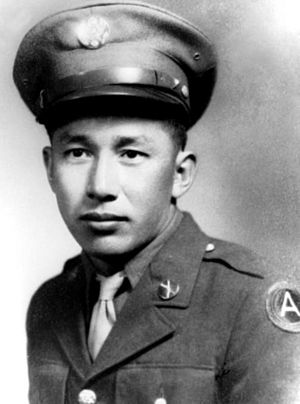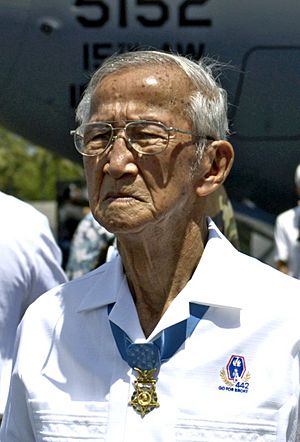Barney F. Hajiro facts for kids
Quick facts for kids
Barney F. Hajiro
|
|
|---|---|

Barney F. Hajiro, Medal of Honor recipient
|
|
| Born | September 16, 1916 Territory of Hawaii |
| Died | January 21, 2011 (aged 94) Maunalani Care Home, Honolulu, Hawaii |
| Buried |
National Memorial Cemetery of the Pacific
|
| Allegiance | |
| Service/ |
|
| Years of service | 1942 – 1945 |
| Rank | |
| Unit | 442nd Regimental Combat Team |
| Battles/wars | World War II |
| Awards | |
Barney Fushimi Hajiro (September 16, 1916 – January 21, 2011) was an American combat veteran of World War II who received the Medal of Honor, the highest United States military award for valor.
Contents
Biography
Early years
Hajiro was born in Hawaii, the second to the eldest of nine children born to Japanese immigrant parents His parents had moved from Hiroshima to Maui during World War I. Two of his siblings died in infancy. The family was poor, and Hajiro left school to work, first in the sugarcane fields of Maui and later as a stevedore in Honolulu.
U.S. Army
World War II
Two months after the Japanese attack on Pearl Harbor, he was drafted into the U.S. Army and performed menial labor as part of an engineering battalion.
In March 1943, Hajiro volunteered to be part of the Army's all-Nisei 442nd Regimental Combat Team. The 442nd was mostly made up of second-generation Americans citizens of Japanese descent from Hawaii and the mainland. The unit was sent to Europe and in May 1944 fought the Germans in Italy, north of Rome. From there the 442nd was redeployed to France.
On October 19, 1944, the 442nd was fighting near Bruyères and Biffontaine in eastern France and over the next ten days, Hajiro, a private in Company I, repeatedly distinguished himself in battle. He exposed himself to enemy fire while assisting an Allied attack on October 19, and three days later he and a comrade ambushed an 18-man enemy patrol. On October 29, during the rescue of the so-called "Lost Battalion", which had been surrounded by German forces in the Vosges Mountains, he single-handedly destroyed two German machine gun emplacements. Afterwards, in another firefight, he was shot in the shoulder and wrist leaving his left arm partially paralyzed. He was able to rejoin the 442nd in Monte Carlo, but was barred from further combat duty. He was then sent back to the United States to recover.
Hajiro was recommended for the Medal of Honor for his actions in October 1944. He received the Distinguished Service Cross and the World War II Victory Medal before he was honorably discharged.
Post-war and later years
In 1948, he was awarded the Military Medal by the British government. A 1990s review of U.S. military service records for personnel of Asian descent who had received the Distinguished Service Cross during World War II led to Hajiro's Distinguished Service Cross being upgraded to the Medal of Honor. President Bill Clinton presented Hajiro the Medal of Honor during a ceremony at the White House on June 21, 2000. Twenty-one other former U.S. military personnel of Asian descent also received the Medal of Honor during the ceremony, fifteen of them posthumously. In 2004, the French awarded Hajiro the Legion of Honor.
Death
Hajiro was the oldest living Medal of Honor recipient for seven months. He died on January 21, 2011, in Waipahu, Hawaii.
Military decorations and awards
Hajiro's military awards include:
 Medal of Honor
Medal of Honor Bronze Star Medal
Bronze Star Medal Purple Heart
Purple Heart Army Presidential Unit Citation
Army Presidential Unit Citation Army Good Conduct Medal
Army Good Conduct Medal American Campaign Medal
American Campaign Medal European-African-Middle Eastern Campaign Medal
European-African-Middle Eastern Campaign Medal World War II Victory Medal
World War II Victory Medal British Military Medal
British Military Medal French Legion of Honor
French Legion of Honor French Liberation Medal
French Liberation Medal Combat Infantryman Badge
Combat Infantryman Badge
See also


